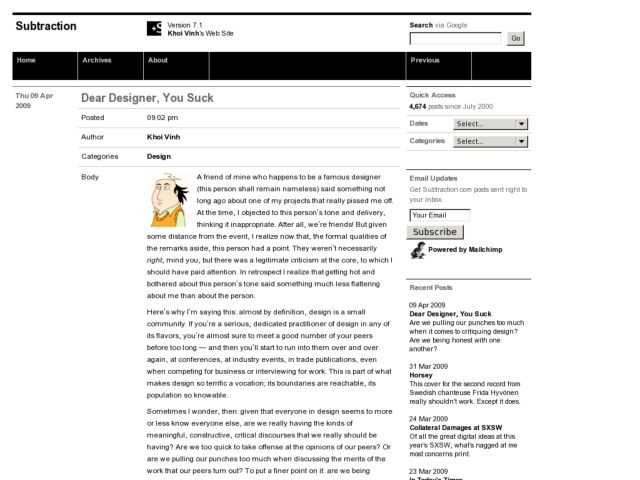Khoi Vinh wrote an entry on taking the need for criticism inside the studio, and extending that openness in engaging in critical dialogue to discussion with peers outside of your working groups.
Like it or not, you can’t have a serious discourse about an art form until you have people whose sole involvement in that art form is criticism. You need, in effect, an independent press. Actually, to be clear, what you need is an economic model that can support a corps of passionate, clear-thinking individuals who are dedicated to vigilantly watching over the progression of the medium. Recent troubles aside, this is why art, film and architecture have achieved such great heights in our society: those art forms are economically robust enough to support a vibrant critical class.
Design is far from having that. Especially the design forms to which I’m closest: graphic design, Web design, interaction design. We have lots of smart people writing actively about design, pushing ourselves to do better design, but we have very few design critics who remain apart from the practitioners. We need more.
I, like many of you I'm sure, succeed because of the design critique. The design crit allows us to view design solutions among peers who can vet every aspect of what's been designed--the good and bad--from the perspective of someone other than the designer presenting the concept. Questioning what we've done and why and suggesting alternative views that we might not have considered allows the designer to move forward and find the right design. If you do creative work to be used by others, you can't understimate the value of peer criticism.
But the design crit is a civil dialogue and public criticism outside of the controlled environment of the studio can be very different, and often personal. Opening up to criticism in the general sense, is partially why I take the risk of blogging. The risk in blogging is opening yourself up to criticism by sharing what you believe when you write or sharing how and what you do when you design. Something in what Vinh writes resonates with me. I've always flinched a little when I've read people criticize stuff I do indirectly, e.g. on Twitter, on comments in some blog. But I seek it out. And I try to react to it in a civil way because I learn from it.
There's something about the idea of being open to criticism outside of teams you're directly involved with, and feeling open to being critical. If you know my writing style, you know I can be tentative and polite about things I disagree with in the showcase entries. But I do think that the entries are most interesting when there's something to have a dialog about. To be sure, I'm not creating a design pattern gallery here. I'm documenting examples of the good, the different, and the not so good in order to find things that challenge my ideas and see what I feel about them. Somewhere in there there is criticism.
I like what Khoi is writing here, because it feels like he's inviting a change in the tenor of our discussion by saying that he wants more of it. I'm certainly interested in doing the same, particularly as it regards user interface design.
http://www.subtraction.com/2009/04/09/dear-designer-you-suck
